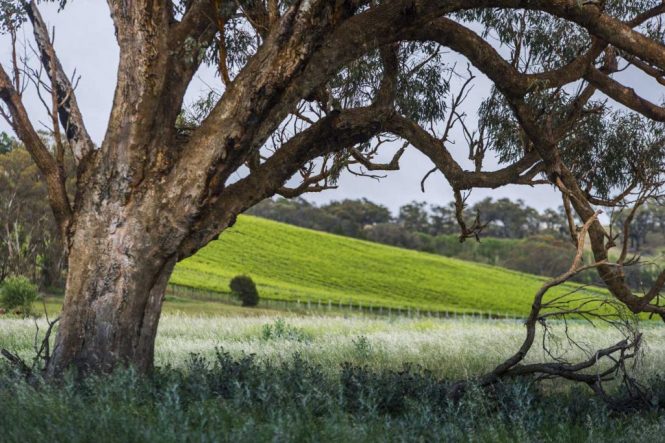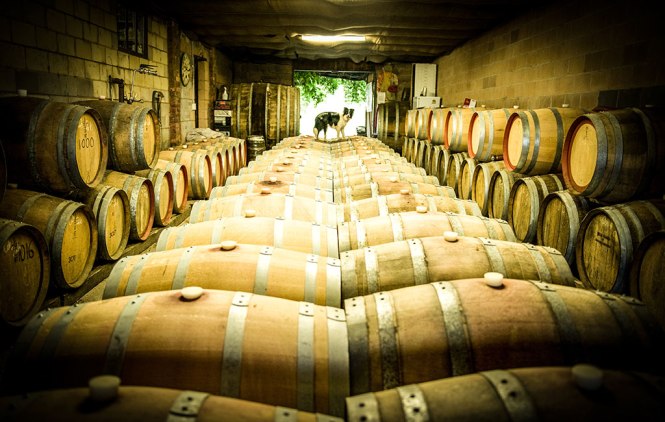Canberra – a well deserved rise to fame
The Canberra District is a small wine region in the ACT (Australian Capital Territory), with very blurred lines separating it from nearby regions in surrounding New South Wales like Hilltops, Lake George and even Tumbarumba. Partly these regions are conflated because they share similar climate, and are growing from obscurity at a similar time.
Among these regions, the Canberra District has the strongest growth, but it’s still tiny. Official pages cite 30+ wineries, but I think they may be crossing some of the above blurred lines to get that number.
Yet despite the not-quite fledgling status of the region, Canberra has a strong reputation. In fact it’s quickly becoming a very badly kept secret. The reason for Canberra’s growth is quality. There are no big producers here, and the total output would be a small drop in the large vat of Australia’s national production. But the quality and uniqueness of the wines is attracting a lot of attention.
There’s a somewhat useful map at canberrawines.com.au, but I was hoping for something a bit more artistic than a google map overlay.

Climate
Canberra is a hot, dry place in summer, but its relatively high elevation (in Australia we have a race track that covers a “mountain”) means that it cools off in the evening. And the landscape is very hilly, allowing the wineries to hide in favourable microclimates. The diurnal temperature variation helps the grapes achieve ripeness while maintaining more acidity than seen in hotter regions, where acid is often added during the wine making process.
Cool climate in Australia from Canberra, Tasmania and Victoria are seeing a surge in interest. The wines are more balanced and lower alcohol than South Australian powerhouses, which makes them more approachable and often better with food. Certainly I haven’t seen anything from Canberra I’d class as full bodied.

The vineyard at Clonakilla
Varietals and style
Shiraz/Syrah
Where Australia typically calls these wines Shiraz, you’ll occasionally hear Syrah instead, usually to distinguish the wine from the big bold Shiraz of South Australia, and to link it with Rhone style Syrah.
This is where a lot of the attention on Canberra is focused. The Shiraz here is a world away from the big South Australian versions that regularly weigh in around 15% alcohol or more. Canberra Shiraz is more medium-bodied, aromatic and somewhat spicy. It’s not so dominated by a single powerful fruit flavour. The tannins are also more moderate, and the result is a well balanced wine that will cellar for 10-15 years, but doesn’t need long term cellaring just to get to the point of good drinking.
This is my favourite style from Canberra, and it’s fantastic to see it growing. Over time more producers are seeing success with Shiraz, and quality is rising as well.
Shiraz Viognier
Closely related to the above, Shiraz Viognier is a Rhone inspired style where a small amount of Viognier (a white grape) is fermented in the same barrels as the Shiraz (co-fermentation). The Viognier adds different aromatics and flavours to the wine that complement and balance the bolder Shiraz. It’s not distinguishable (at least not to me), it just makes for a more interesting and flavourful wine. It’s somewhat akin to adding seasoning to food – it’s there to round out and accentuate the dominant flavours.
This style has been championed by Clonakilla, whose winemaker Tim Kirk is a big fan of Rhone style Shiraz. Such is the quality of the wines he’s made that he has almost single handedly built the reputation of both Canberra and Shiraz Viognier within Australia.
In recent years many estates have seen success with Shiraz Viognier, and Canberra is leading the charge for this style in Australia. When visiting Canberra, Shiraz and Shiraz Viognier are must tries.

Riesling
The other grape driving Canberra’s growth is Riesling. Riesling requires both ripeness and acidity, which is why the climate in Canberra (and Tasmania) is so ideal for this variety. Helm has a few different Rieslings in their line-up, which make an interesting comparison. For me, Clonakilla’s Riesling has been a reliable winner, and good value too. It’s a wine that’s worth drinking both young and old, so I try to buy a few so I have some to keep for later.
Other varietals
You’ll also find Cabernet (Helm is a good example), Viognier (Clonakilla), Pinot Noir, Chardonnay. And as in other parts of Australia, there’s some experimentation with Tempranillo and other non-French European varieties. As Canberra is such a young wine region, all we really know so far is that Shiraz and Riesling do well here. Otherwise the rest is still being discovered.
Visiting
Canberra is 3 hours’ drive from Sydney, though some of the wineries are a little closer. So it’s possible to do in a day trip from Sydney, though it’s a lot of driving. From Canberra, the wineries are 30-60 minutes’ drive. Some wineries are open part week (eg Eden Road – open Wed-Sun), so if you’re not visiting on a weekend, check ahead.
Most wineries are open for walk-ins, with reservations requested or required for larger group visits. This is a good thing – it means the cellar doors are small and you’ll hopefully get more personal attention. Half drunk stag dos looking for a top-up can ruin a cellar door in seconds.
As far as I’m aware, no one charges a tasting fee (including Clonakilla, where you can taste the magnificent ~$100 Shiraz Viognier).
All in all, the barrier to entry is pretty low. Being able to taste some of the best wines in Australia in small cellar doors is a great experience. Clonakilla has upgraded to a more medium sized affair from their old tasting shack. But considering their reputation and quality, it’s a long way from the conveyor belt, cookie cutter experience you might expect from other big names.

Mount Majura’s vineyard
Wineries
I’ve visited the below wineries on many occasions over the years, and can recommend them all.
Clonakilla
Clonakilla really started a fire under the Canberra wine scene by showing what was possible to get from the region with the right passion for wine. There’s little here I don’t like (the Viognier Nouveau is not my favourite), though I haven’t tasted some of the small batch wines like the Pinot Noir, Ceoltoiri and Balinderry. That hasn’t stopped me ordering some of them!
The standout here will always be the Shiraz Viognier for which Clonakilla is famous. Don’t miss tasting it. In a similar vein is the O’Riada Shiraz, at a more affordable price, it’s top quality drinking. The Hilltops shiraz is also a good example of cool climate Shiraz, but the O’Riada usually trumps it for me. In good years I try to remember to buy a Shiraz Viognier and as many O’Riada as seems justifiable at the time.
That’s a lot to say just on Shiraz. One of the best things about visiting Clonakilla is what else is on for tasting. The Viognier is quite good, and unusual in Australia. The Riesling is always good and worth a buy. If you’re at the right time of year, you might get to taste some of the small batch wines, including the Syrah, which is a pure Shiraz made from a subsection of the grapes used for the Shiraz Viognier.
Eden Road
Eden Road do an interesting range of wines highlighting different regions in the area (eg: Canberra, Tumbarumba, Gundagai). The lineup seems to vary quite a bit, I’m not sure if this is them honing in on what their main wines are, or perhaps them taking each year as it comes and making the best they can from it.
The variation is mostly a good thing, because you can get some nice surprises. I have a bottle of 2013 Syrah I’ve brought over to Seattle as one of the chosen few we lugged over here. It was great at the cellar door and very different from other years.
The Shirazes are generally my favourites. Comparing different regions’ Shiraz is interesting. The Pinot is also good, some years better than others. The Long Road range is decent, but I don’t drive to Canberra to buy $25 bottles.
Helm
The first thing to say about Helm is that you need to be prepared to meet Ken Helm. He’s a large character who’s proud of his wine. And the wine is good. If you like a bit of banter with your wine tasting, this is the place for you.
Ken is probably most proud of his Rieslings, and being able to taste a few different versions is a good opportunity. But for me, the best wine I’ve had from there is actually their Premium Cabernet Sauvignon.
The location is nice, set next to an old schoolhouse. The tasting room itself is small and quaint, so you get very individual attention here. Also as a result, they’re not keen on large groups.

Helm’s cellar (plus dog)
Mount Majura
I only visited Mount Majura for the first time in December 2017, taking the short trip out there from Canberra’s centre. I really enjoyed the visit there, and put it on my mental list of places to go back to when I get the chance.
Mount Majura presents some great options for tasting, including several Tempranillo wines made from different blocks of the vineyard, as well as a blend. Comparing the different characters of these wines was quite interesting.
Unfortunately you can’t buy everything (well, I can’t), and I just couldn’t go past their 2015 Shiraz. This was fantastic, especially in the mid-$30 range. This wine has been making a splash for Mount Majura in the press, and I expect future vintages will show similar quality.
Other options
There are a lot of wineries in the region I still have my to-go list, all having their own unique character. Here are some more suggestions you might want to check out:
- Lark Hill
- Lerida Estate
- Gundog Estate (also established in the Hunter Valley)
- McKellar Ridge
- Shaw Wines
You can get a full list at visitcanberra.com.au.
See more from me on wine here.


[…] Canberra District […]
LikeLike